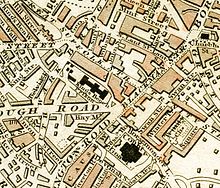Horsemonger Lane Gaol
| Act of Parliament | |
 | |
| Long title | An Act for building a new Common Gaol and Session House, with Accommodations thereto, for the County of Surrey, and for disposing of the present County Gaol and the Ground thereto belonging. |
|---|---|
| Citation | 31 Geo. 3. c. 22 |
| Dates | |
| Royal assent | 13 May 1791 |
Horsemonger Lane Gaol (also known as the Surrey County Gaol or the New Gaol) was a prison close to present-day Newington Causeway in Southwark, south London. Built at the end of the 18th century, it was in use until 1878.
History

The gaol was built to replace the old county gaol housed at what had been the nearby 'White Lion Inn' on Borough High Street, Southwark (informally called the 'Borough Gaol').[1] The new building was designed by George Gwilt the Elder, surveyor to the county of Surrey, and completed in 1799.[1] It was adjacent to Sessions House, a court building also designed by Gwilt.[2]
Horsemonger Lane remained Surrey’s principal prison and place of execution up to its closure in 1878. It was a common gaol, housing both debtors and criminals, with a capacity of around 300 inmates. In total, 131 men and four women were executed there between 1800 and 1877, the gallows being erected on the flat roof of the prison's gatehouse until abolition of public executions in 1868, and then in a yard behind the walls.[3]
By 1859, the gaol was no longer known as 'Horsemonger Lane' following the road's change of name to Union Road (today: Harper Road), being renamed Surrey County Gaol (although its alternative name, the New Gaol, should not be confused with the New Prison, located north of the River Thames in Clerkenwell).[4]
The gaol was demolished in 1881 and replaced by the Inner London Crown Court, and a public park, Newington Gardens, which opened in 1884.[5]
Literary connections
In 1849, Charles Dickens attended the public hangings outside the gaol of husband and wife Frederick and Maria Manning, who had killed a friend for his money and buried him under the kitchen floor. Dickens wrote to The Times condemning such public spectacles.[6]
Dickens later based the character of Hortense in Bleak House on Maria Manning, while Mrs Chivery's tobacco shop in Little Dorrit is located on Horsemonger Lane.[7] Executions at Horsemonger Lane are also mentioned in Sarah Waters' novel Fingersmith.[8]
Inmates
Inmates included:
- William Chester Minor, convicted of murder[9]
- Edward Despard, convicted of high treason (executed at the gaol on 21 February 1803)[10]
- Leigh Hunt, convicted of criticism of the Prince Regent[11]
- Marie and Frederick Manning, convicted of murder (executed at the gaol on 13 November 1849)[12]
- Robert Taylor, convicted of blasphemy[13]
- Arthur Tooth, convicted of contempt of court[14]
- Margaret Waters, convicted of murder (executed at the gaol on 11 October 1870)[15]
See also
References
- ^ a b Darlington, Ida (1955). "'Southwark Prisons', in Survey of London: Volume 25, St George's Fields (The Parishes of St. George the Martyr Southwark and St. Mary Newington)". London: British History Online. pp. 9–21. Retrieved 17 October 2020.
- ^ Historic England. "Inner London Sessions Court (1385732)". National Heritage List for England. Retrieved 17 October 2020.
- ^ "Horsemonger Lane Gaol". capitalpunishmentuk.org. Retrieved 17 October 2020.
- ^ "House of Detention reveals its spectacular underground past". New Civil Engineer. 21 April 2009.
- ^ "London Gardens Online Newington Gardens". London Gardens Online. London Parks and Gardens Trust. 2012. Retrieved 14 September 2013.
- ^ "Maria and Frederick Manning". capitalpunishmentuk.org. Retrieved 17 October 2020.
- ^ Dickens' London map Archived 2013-01-23 at the Wayback Machine
- ^ "Fingersmith". The Times. 11 June 2005.
- ^ "William Chester Minor", Documents (PDF) (biography), Berkshire, UK: Record office, archived from the original (PDF) on 28 November 2009.
- ^ "Poldark: the remarkable true story behind character Ned Despard". Southwark News. 15 August 2019.
- ^ Byron's letter "To Thomas Moore: Written The Evening Before His Visit To Mr. Leigh Hunt in Horsemonger Lane Gaol, 19 May 1813"
- ^ "Maria and Frederick Manning". capitalpunishmentuk.org. Retrieved 18 October 2020.
- ^ "Blasphemous publications: case of Robert Taylor". Hansard. 22 July 1831.
- ^ "Arthur Tooth". London: The Catholic Literature Association. 1933. Retrieved 18 October 2020.
- ^ Davies, Charles Maurice (1875). "Mystic London". Retrieved 18 October 2020.
External links
- London footprints: Crime & Punishment
- 'The Old Kent Road', Old and New London: Volume 6 (1878), pp. 248–55. URL: http://www.british-history.ac.uk/report.asp?compid=45279. Date accessed: 19 December 2006.
- Old Towns of England, London in 1839, Pt 6
- Index to deaths, 1798-1878, in Surrey County Gaol
